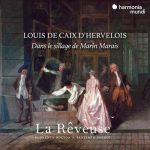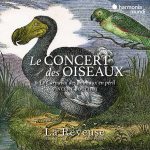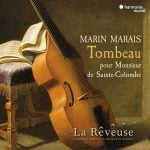

Composer: Pietro Castrucci, George Frideric Handel, James Oswald, Giuseppe Sammartini, Carl Friedrich Weidemann
Performer: La Rêveuse, Florence Bolton, Benjamin Perrot
Format: FLAC (tracks)
Label: Harmonia Mundi
Catalogue: HMM902613
Release: 2023
Size: 2.12 GB
Recovery: +3%
Scan: yes
Weidemann: Concerto No. 6 for German Flute, Op. 2
01. I. Adagio e grazioso
02. II. Allegro assai
03. III. Amoroso
Handel: Trio Sonata, HWV 390a in G minor, Op. 2 No. 5
04. I. Larghetto
05. II. Allegro
06. III. Adagio
07. IV. Allegro
Sammartini: Concerto a piu istromenti in F major (for fifth flute)
08. I. Allegro
09. II. [Siciliano]
10. III. Allegro assai
Castrucci: Sonata for viola da gamba
11. I. Affectuoso
12. II. Allegro
13. III. Giga
Oswald: The Caledonian Pocket Companion
14. Hugar Mu Fean
15. Sleepy Maggy
Oswald: A Sonata of Scots Tunes
16. I. O Mother what shall I do (Largo)
17. II. Ettrick Banks (Adagio)
18. III. She rose and let me in (Andante)
19. IV. Cromlit’s Lilt (Largo)
20. V. Polwart on the Green (Andante)
Oswald: The Caledonian Pocket Companion
21. The Cameronian’s Rant
22. Up in the Morning Early
23. Handel: Hornpipe in D, HWV 356
For this new instalment of their series devoted to British music of the eighteenth century, the musicians of La Rêveuse take us to London in the 1740s. The leading Italian and German virtuosos Handel invited to play in his orchestra brought a powerful wind of change to English musical life, while the Scot James Oswald achieved the tour de force of making the music of his country fashionable in the drawing rooms of London.
Various recordings have aired the music of Handel’s contemporaries, but this one from the ensemble La Rêveuse delves deeper than others, and the players make excellent cases for the music. It is worth keeping in mind that Handel, like Bach, was on the old-fashioned side by the 1740s, and the younger musicians in his orbit, many of them immigrants, were more open to new trends. One of those was the transverse flute, sometimes known as the German flute, and the light, virtuosic concerto by Charles Weideman (a German actually named Carl Weidemann) offers an excellent example of the new music being written for it. There are pieces by the Italians Pietro Castrucci and Giuseppe Sammartini — the older brother of Giovanni Battista Sammartini — that carry hints of the emerging galant style. New musical breezes were also blowing from Scotland, and the pieces by James Oswald reflect this; these are the most interesting things on the album, and they’re far from commonly played. Some are from a collection called The Caledonian Pocket Companion; these are transcriptions of folk tunes, some of which one might hear today during an evening out at a Scottish pub. Most unusual of all is A Sonata of Scots Tunes, a five-movement work in which the folk material is shoehorned into an Italian sonata style. This absolutely deserves wider distribution, and the album, as a whole, is fresh. Another draw are the detailed liner notes by viola da gamba player Florence Bolton; they contain lots of information, not all of it directly relevant to the music at hand, but all of interest to lovers of the period (maybe music for the Aeolian harp or the violetta marina will be coming up on subsequent releases). The church sound is wrong, but this is apparently the first in a series of English music from these fine musicians, and one looks forward to more.



